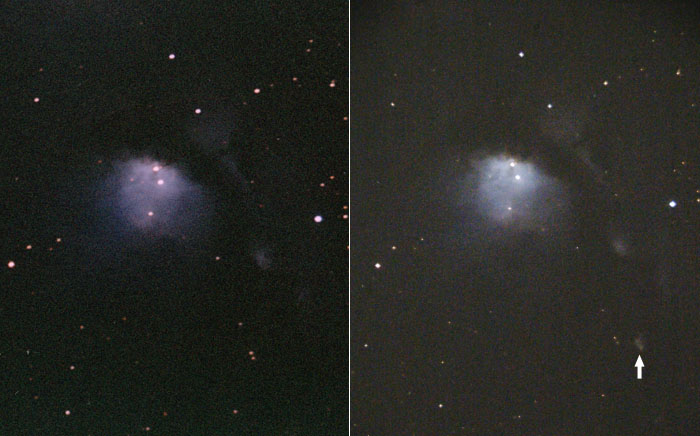| Date & Time: | Nov 2 2002, 24:16 to 24:56 & 25:43 JST(+0900) | Feb 21 2004, from 19:25 to 19:33 JST(+0900) |
| Composed 2 images with 40min. exposed | Composed 2 images with 7min. exposed |
| Optical: | Meade 25cm(10") Schmidt-Cassegrain (f=2500mm, F10.0) | Meade 25cm(10") Schmidt-Cassegrain & reducer (f=1600mm, F6.3) |
| Auto-guided with Meade LX200 Equatorial & Meade Pictor 201XT | same the left |
| Camera: | VIXEN VX-1 | Fujifilm FinePix S2 Pro digital camera |
| Film: | Konica New Centuria Super 1600 | - |
| Location: | Ooizumi vil., Yamanashi pref. | same the left |
| M78 (NGC2068) / Reflection Nebula, type 1 R |
|---|
| R.A. | 05h 46m 42.0s (2000.0) |
|---|
| Dec. | +00° 03' 00" (2000.0) |
|---|
| Apparent Size | 8' |
|---|
| Real Size | 3.7 light yrs. |
|---|
| Magnitude | 8.3 |
|---|
| Distance | 1600 light yrs. |
|---|
| Other IDs | LBN939 |
|---|
An American amateur astronomer Mr. J.W.McNeil has discovered an appearance of small nebula just southwest of M78 in Orion on Jan 23, 2004.
This rare event has been considered that an embryo star surrounded by dark nebula had a sudden brightening, the outburst, and lighted the dark clouds up drastically.
Now we're calling this new nebula "The McNeil's Nebula".
An upper comparison images show you two shots of M78 captured in Nov 2002 and Feb 2004, respectively.
A right shot shows us a compact dimmed nebula indicating an arrow.
The nebula has a visual brightness of about 14th or 15th magnitude, and a shape of stretched lump in north-south direction.
It's a very infrequent case that such an object was discovered by amateur small telescope (3" refractor !).
Back to previous image
|

